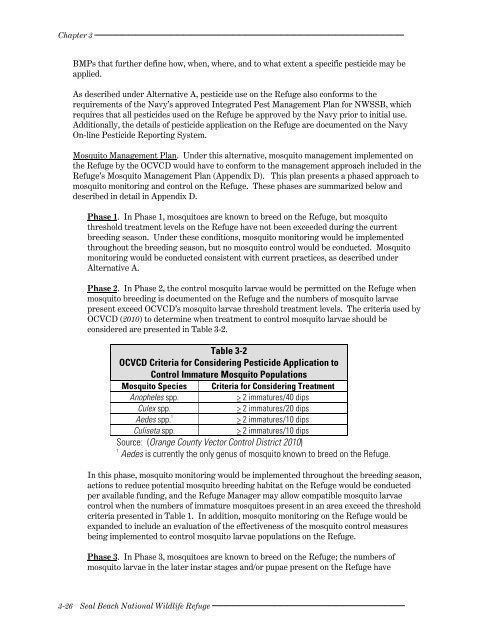Chapters 1 - U.S. Fish and Wildlife Service
Chapters 1 - U.S. Fish and Wildlife Service
Chapters 1 - U.S. Fish and Wildlife Service
You also want an ePaper? Increase the reach of your titles
YUMPU automatically turns print PDFs into web optimized ePapers that Google loves.
Chapter 3 <br />
BMPs that further define how, when, where, <strong>and</strong> to what extent a specific pesticide may be<br />
applied.<br />
As described under Alternative A, pesticide use on the Refuge also conforms to the<br />
requirements of the Navy’s approved Integrated Pest Management Plan for NWSSB, which<br />
requires that all pesticides used on the Refuge be approved by the Navy prior to initial use.<br />
Additionally, the details of pesticide application on the Refuge are documented on the Navy<br />
On-line Pesticide Reporting System.<br />
Mosquito Management Plan. Under this alternative, mosquito management implemented on<br />
the Refuge by the OCVCD would have to conform to the management approach included in the<br />
Refuge’s Mosquito Management Plan (Appendix D). This plan presents a phased approach to<br />
mosquito monitoring <strong>and</strong> control on the Refuge. These phases are summarized below <strong>and</strong><br />
described in detail in Appendix D.<br />
Phase 1. In Phase 1, mosquitoes are known to breed on the Refuge, but mosquito<br />
threshold treatment levels on the Refuge have not been exceeded during the current<br />
breeding season. Under these conditions, mosquito monitoring would be implemented<br />
throughout the breeding season, but no mosquito control would be conducted. Mosquito<br />
monitoring would be conducted consistent with current practices, as described under<br />
Alternative A.<br />
Phase 2. In Phase 2, the control mosquito larvae would be permitted on the Refuge when<br />
mosquito breeding is documented on the Refuge <strong>and</strong> the numbers of mosquito larvae<br />
present exceed OCVCD’s mosquito larvae threshold treatment levels. The criteria used by<br />
OCVCD (2010) to determine when treatment to control mosquito larvae should be<br />
considered are presented in Table 3-2.<br />
Table 3-2<br />
OCVCD Criteria for Considering Pesticide Application to<br />
Control Immature Mosquito Populations<br />
Mosquito Species Criteria for Considering Treatment<br />
Anopheles spp. > 2 immatures/40 dips<br />
Culex spp. > 2 immatures/20 dips<br />
Aedes spp. 1 > 2 immatures/10 dips<br />
Culiseta spp. > 2 immatures/10 dips<br />
Source: (Orange County Vector Control District 2010)<br />
1 Aedes is currently the only genus of mosquito known to breed on the Refuge.<br />
In this phase, mosquito monitoring would be implemented throughout the breeding season,<br />
actions to reduce potential mosquito breeding habitat on the Refuge would be conducted<br />
per available funding, <strong>and</strong> the Refuge Manager may allow compatible mosquito larvae<br />
control when the numbers of immature mosquitoes present in an area exceed the threshold<br />
criteria presented in Table 1. In addition, mosquito monitoring on the Refuge would be<br />
exp<strong>and</strong>ed to include an evaluation of the effectiveness of the mosquito control measures<br />
being implemented to control mosquito larvae populations on the Refuge.<br />
Phase 3. In Phase 3, mosquitoes are known to breed on the Refuge; the numbers of<br />
mosquito larvae in the later instar stages <strong>and</strong>/or pupae present on the Refuge have<br />
3-26 Seal Beach National <strong>Wildlife</strong> Refuge

















